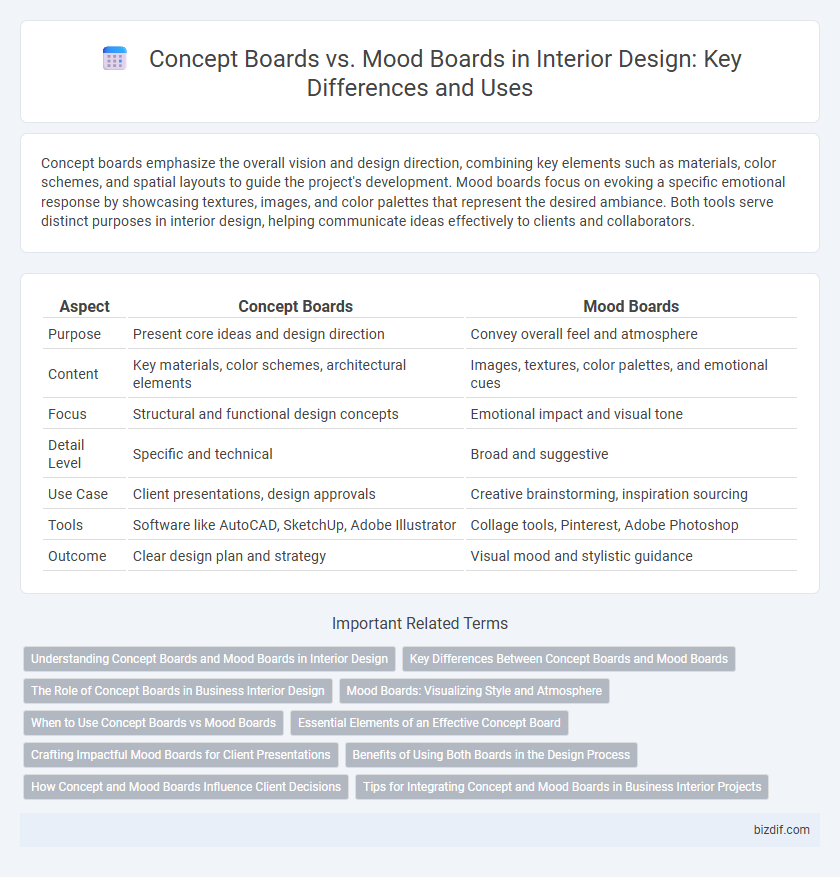Concept boards emphasize the overall vision and design direction, combining key elements such as materials, color schemes, and spatial layouts to guide the project's development. Mood boards focus on evoking a specific emotional response by showcasing textures, images, and color palettes that represent the desired ambiance. Both tools serve distinct purposes in interior design, helping communicate ideas effectively to clients and collaborators.
Table of Comparison
| Aspect | Concept Boards | Mood Boards |
|---|---|---|
| Purpose | Present core ideas and design direction | Convey overall feel and atmosphere |
| Content | Key materials, color schemes, architectural elements | Images, textures, color palettes, and emotional cues |
| Focus | Structural and functional design concepts | Emotional impact and visual tone |
| Detail Level | Specific and technical | Broad and suggestive |
| Use Case | Client presentations, design approvals | Creative brainstorming, inspiration sourcing |
| Tools | Software like AutoCAD, SketchUp, Adobe Illustrator | Collage tools, Pinterest, Adobe Photoshop |
| Outcome | Clear design plan and strategy | Visual mood and stylistic guidance |
Understanding Concept Boards and Mood Boards in Interior Design
Concept boards in interior design serve as structured visual presentations showcasing core ideas, color schemes, textures, and spatial layouts to communicate the overarching theme of a project. Mood boards emphasize the emotional tone and ambiance through curated images, materials, and inspirational elements that evoke specific feelings and style directions. Understanding the distinction between concept and mood boards enables designers to effectively convey both the technical framework and the aesthetic vision to clients and collaborators.
Key Differences Between Concept Boards and Mood Boards
Concept boards focus on the overall design vision by integrating spatial layouts, furniture selections, and architectural elements, while mood boards emphasize color palettes, textures, and inspirational images to evoke a specific emotional tone. Concept boards serve as strategic guides for project development, highlighting functional and structural components, whereas mood boards prioritize the ambiance and aesthetic feelings to shape the design atmosphere. The key difference lies in concept boards presenting practical implementation details, while mood boards focus on artistic inspiration and mood setting.
The Role of Concept Boards in Business Interior Design
Concept boards in business interior design serve as strategic tools that translate client goals into cohesive visual representations of layout, materials, and functional elements. They guide decision-making by aligning spatial planning with brand identity, ensuring that the environment supports productivity and corporate culture. Unlike mood boards, which emphasize aesthetics and emotional tone, concept boards prioritize practical design solutions, enhancing project efficiency and stakeholder communication.
Mood Boards: Visualizing Style and Atmosphere
Mood boards serve as essential tools in interior design, capturing the intended style and atmosphere through curated images, textures, and color palettes. They help designers and clients visualize the emotional tone and overall vibe of a space before selecting specific furnishings and decor. By focusing on ambiance and sensory elements, mood boards provide a cohesive reference that guides creative decisions throughout the design process.
When to Use Concept Boards vs Mood Boards
Concept boards are ideal during the initial phase of an interior design project to communicate overall ideas, spatial arrangements, and functional elements through sketches, diagrams, and material samples. Mood boards serve best when refining the aesthetic direction, capturing color palettes, textures, and emotional tone to guide visual style choices. Use concept boards to align project goals with client needs and mood boards to evoke atmosphere and ambiance, ensuring cohesive design development.
Essential Elements of an Effective Concept Board
An effective concept board in interior design includes clear spatial layouts, key materials such as fabric swatches and finishes, and a defined color palette that guides the overall aesthetic direction. Incorporating images of furniture styles, lighting options, and architectural details ensures a cohesive vision aligned with the project's goals. Precise annotations and scaled sketches enhance communication between designers and clients, facilitating a well-rounded presentation of the design concept.
Crafting Impactful Mood Boards for Client Presentations
Crafting impactful mood boards for client presentations involves selecting carefully curated images, textures, and color palettes that evoke the desired atmosphere and design intent. Unlike concept boards, which focus on specific design elements and details, mood boards create an emotional connection by showcasing the overall feeling of the space. Effective mood boards integrate cohesive visual storytelling to align client expectations with interior design visions, ensuring clear communication and project approval.
Benefits of Using Both Boards in the Design Process
Using both concept boards and mood boards in interior design enhances creative clarity by combining structured design elements with emotional atmosphere, offering a comprehensive visual guide. Concept boards provide detailed design plans and material selections, ensuring practical functionality, while mood boards evoke the desired ambiance and style, driving emotional connection. This dual approach streamlines client communication and decision-making, resulting in cohesive and well-rounded interior spaces.
How Concept and Mood Boards Influence Client Decisions
Concept boards communicate the overall design vision by combining colors, materials, and spatial layouts, helping clients visualize the final outcome. Mood boards evoke emotional responses through textures, images, and ambiance, guiding clients toward a preferred aesthetic direction. Together, these tools streamline decision-making by aligning client expectations with the designer's creative intent.
Tips for Integrating Concept and Mood Boards in Business Interior Projects
Concept boards provide a structured vision with materials, color palettes, and layouts, while mood boards capture the emotional tone and ambiance through images and textures. To effectively integrate both in business interior projects, align mood board themes with the functional goals outlined in the concept board to ensure cohesive design communication. Use digital tools like Canva or Milanote for seamless collaboration and real-time updates with clients and contractors.
Concept boards vs Mood boards Infographic

 bizdif.com
bizdif.com